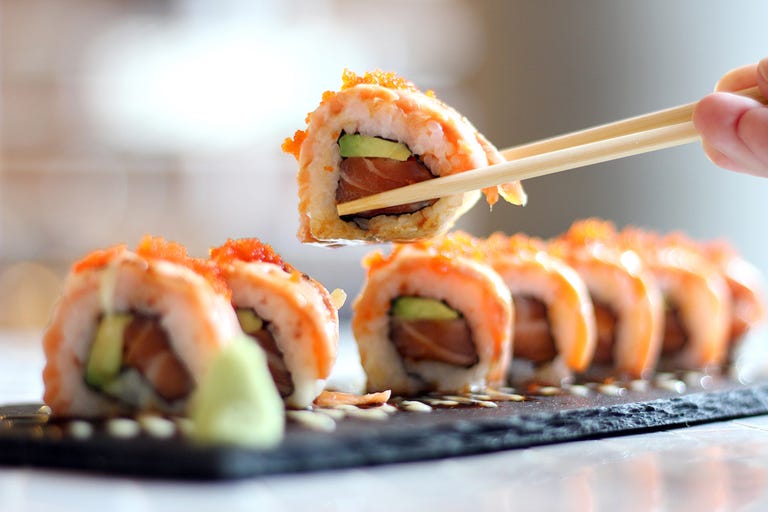
You’ve seen the Instagram quotes: You had me at sushi. Soy happy together. Keep calm and eat sushi. Corny, sure, but it’s all good because sushi = fish = totally healthy.
That’s true—for the most part. But certain rolls (ahem: the fried and mayo-laden Kamikaze roll) are closer to French fries in nutrition, says Jessica Perez, R.D.
Not a big deal once in a while—but if you didn’t intend for your seaweed salad to come with a side of saturated fat, disturbing nonetheless.
So yeah…is sushi healthy?
Yes, Perez says…but again, it it really depends on what you order.
Aim for a serving of fatty fish like salmon at least once a week, she says. Fatty fish contains memory-boosting omega-3 fatty acids, so it gets a big thumbs up from most R.D.s.
But there’s a catch: You should be mindful of your intake of fatty fish like tuna and mackerel, which tend to be higher in mercury. Mercury, of course, is linked to birth defects and can be toxic if consumed at high levels—although some of these fears have been overblown.
Perez recommends only having one or two tuna rolls, and getting the rest of your protein from shrimp, eel, or scallops. (For reference, the FDA says women of childbearing age should eat two to three servings per week of low-mercury fish.)
The other downside of sushi: One roll can contain up to one cup of rice, according to Perez. Yeah, that’s a lot.
White rice doesn’t have much fiber, and it can really spike your blood sugar (leading to a crash, and TBH, probably cravings). So you really don’t want to eat more than a cup and a half of rice total all day—and no more than two-thirds a cup at a time, she says. Ask for fiber-rich brown rice when eating out, or swap the white stuff for cauliflower rice or quinoa when you’re making sushi at home. (Also, damn, congrats on being able to DIY it, girl.)
Of course, if you’re immunosuppressed (undergoing chemo, coping with an autoimmune disease, or pregnant) you should steer clear of raw fish altogether. Raw foods carry a slightly higher risk of passing along a bacterial infection, according to Perez. Cooked fish is still on the table, though.
Healthy sushi options
The fewer crunchy and creamy add-ons, the better. Swap the spicy mayo for a side of pickled ginger for a similar zing. It’s lower in fat, plus the health benefits of ginger are real.
Here are some great options to order:
Perez says rolls like these should be avoided (or treated as an occasional indulgence):
“Get a salmon roll, a veggie roll, and California roll, and that’ll be plenty,” Perez says.
The bottom line: There’s room for sushi in your diet—in moderation. Consider limiting rolls that are fried or filled with other high-calorie ingredients.
Source: Read Full Article